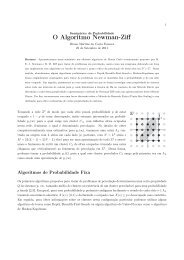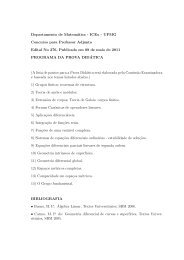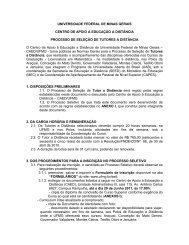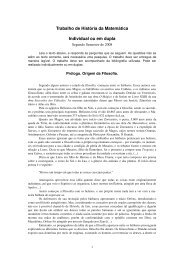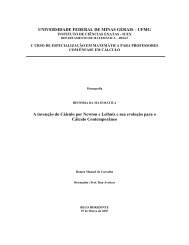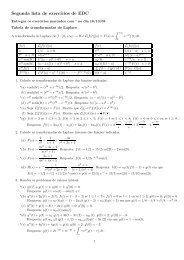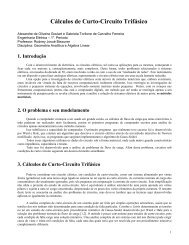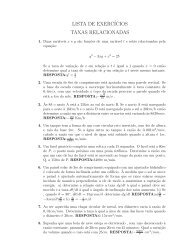As leis de Kepler sob o ponto de vista de Newton - Departamento de ...
As leis de Kepler sob o ponto de vista de Newton - Departamento de ...
As leis de Kepler sob o ponto de vista de Newton - Departamento de ...
You also want an ePaper? Increase the reach of your titles
YUMPU automatically turns print PDFs into web optimized ePapers that Google loves.
c<br />
c<br />
2<br />
2<br />
c<br />
=<br />
=<br />
2<br />
=<br />
d<br />
2 ( 1 − ε )<br />
2<br />
d<br />
ε<br />
2<br />
d<br />
ε<br />
2<br />
2<br />
+<br />
2 ( 1 − ε )<br />
2 ( 1 − ε )<br />
4<br />
ε<br />
d<br />
2<br />
2<br />
2<br />
2<br />
ε<br />
2<br />
d ε<br />
−<br />
1 − ε<br />
4<br />
−<br />
2<br />
d<br />
ou<br />
2<br />
ε<br />
2<br />
2<br />
2<br />
que<br />
⇒<br />
c<br />
2<br />
2<br />
dε<br />
c =<br />
1 − ε<br />
2<br />
=<br />
d<br />
2<br />
ε<br />
2<br />
− ( 1 − ε<br />
2 )<br />
( 1 − ε<br />
2 2<br />
)<br />
Façamos agora, o retorno para o sistema <strong>de</strong><br />
coor<strong>de</strong>nadas original xy:<br />
O centro da elipse é O = (h,0) , ou seja O = (<br />
2<br />
ε<br />
− 2<br />
1 − ε<br />
d<br />
,0) e os focos são:<br />
2<br />
dε<br />
1 − ε<br />
F1 = (c+h , 0) ⇒ ( 2<br />
F1 = (0,0)<br />
2<br />
ε<br />
−<br />
1 − ε<br />
d<br />
2<br />
, 0) , ou seja<br />
F2 = (-c+h , 0)<br />
⇒<br />
F2<br />
=<br />
⎛<br />
⎜ −<br />
⎝<br />
2<br />
dε<br />
2<br />
1 − ε<br />
−<br />
2<br />
dε<br />
2<br />
1 − ε<br />
⎞<br />
, 0 ⎟<br />
⎠<br />
⇒ F2<br />
=<br />
2<br />
⎛ − 2dε<br />
⎜<br />
2<br />
⎝ 1 − ε<br />
⎞<br />
, 0 ⎟<br />
⎠<br />
4.7.<strong>As</strong> <strong>de</strong>scobertas <strong>de</strong> <strong>Newton</strong><br />
No nosso estudo do movimento planetário, verificamos, que quando um planeta está <strong>sob</strong> a<br />
força <strong>de</strong> atração do Sol, ele <strong>de</strong>screve uma trajetória que po<strong>de</strong> ser apresentada, em<br />
coor<strong>de</strong>nadas polares por:<br />
r =<br />
P<br />
1 + ε cosθ<br />
Na seção anterior, quando <strong>de</strong>senvolvemos um estudo sistemático da equação polar <strong>de</strong> uma<br />
cônica, vemos que esta possui a equação:<br />
dε<br />
r<br />
=<br />
1 + ε cosθ<br />
22<br />
d<br />
2<br />
ε<br />
2




